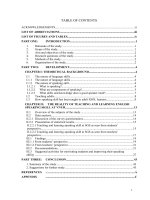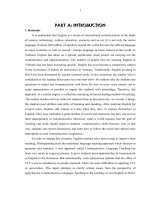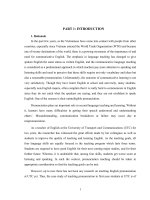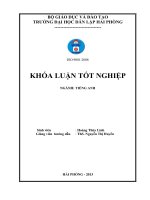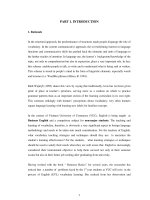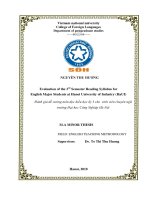An evaluation of appropriateness of applying ‘learn to speak english’ software in teaching speaking skills for non major 1st year students at hanoi university of business and technology
Bạn đang xem bản rút gọn của tài liệu. Xem và tải ngay bản đầy đủ của tài liệu tại đây (4.41 MB, 69 trang )
VIETNAM NATIONAL UNIVERSITY, HANOI
UNIVERSITY OF LANGUAGES & INTERNATIONAL STUDIES
FACULTY OF POST - GRADUATE STUDIES
*****************
PHÙNG THỊ NGỌC HÀ
AN EVALUATION OF APPROPRIATENESS OF
APPLYING “LEARN TO SPEAK ENGLISH”
SOFTWARE IN TEACHING SPEAKING SKILLS FOR
NON- ENGLISH MAJOR 1ST YEAR STUDENTS AT
HANOI UNIVERSITY OF BUSINESS AND
TECHNOLOGY
Đánh giá sự phù hợp của việc áp dụng phần mềm „ Learn to Speak
English‟ trong việc dạy kĩ năng nói cho sinh viên năm thứ nhất không
chuyên Tiếng Anh của trường Đại Học Kinh Doanh và Công Nghệ Hà Nội
M.A. MINOR THESIS
Field: English Teaching Methodology
Code: 601410
Hanoi – 2013
VIETNAM NATIONAL UNIVERSITY, HANOI
UNIVERSITY OF LANGUAGES & INTERNATIONAL STUDIES
FACULTY OF POST - GRADUATE STUDIES
*****************
PHÙNG THỊ NGỌC HÀ
AN EVALUATION OF APPROPRIATENESS OF
APPLYING “LEARN TO SPEAK ENGLISH”
SOFTWARE IN TEACHING SPEAKING SKILLS FOR
NON- ENGLISH MAJOR 1ST YEAR STUDENTS AT
HANOI UNIVERSITY OF BUSINESS AND
TECHNOLOGY
Đánh giá sự phù hợp của việc áp dụng phần mềm „ Learn to Speak
English‟ trong việc dạy kĩ năng nói cho sinh viên năm thứ nhất không
chuyên Tiếng Anh của trường Đại Học Kinh Doanh và Công Nghệ Hà Nội
M.A. MINOR THESIS
Field: English Teaching Methodology
Code: 601410
Supervisor: Đỗ Tuấn Minh, Dr.
Hanoi-2013
DECLARATION
I hereby state that I, Phung Thi Ngoc Ha, K20D, being a candidate for the degree of
Master of Arts (TEFL) accept the requirements of the University relating to the
retention and use of Master‟s Thesis deposited in the library.
In terms of these conditions, I worked on the Thesis on my own and used the
sources of information listed in the references only.
Signature
Hanoi, October 2013
Phung Thi Ngoc Ha
i
ACKNOWLEDGEMENTS
Firstly and foremost, I would like to express my special words of thanks to my
supervisor, Mr. Đỗ Tuấn Minh , Dr. for his constant encouragement, precious
advice and especially for his valuable correction throughout this study. There is no
doubt that without his help, this thesis would be impossible to be accomplished.
I also wish to express my deep gratitude to all teachers from Faculty of Post
Graduate Studies giving lectures and advice that are of great help for me to
complete this study.
I am very grateful to all the teachers of English Division III and all of the students
of three classes at Hanoi University of Business and Technology for their
enthusiastic participation in the survey questionnaire and interview. Without their
help, this thesis would not be able to be completed.
My thanks go to many writers whose important ideas and notions are exploited and
developed in the study.
Finally, I would like to send my deep gratitude to my family and all of my close
friends who are always by my side to take care of and support me in the process of
doing this thesis.
ii
ABSTRACT
With the development of Information and Technology Communication (ITC),
computer- Assisted Instruction (CAI) has been brought into the classroom. CAI is a
kind of instruction that exploits computer software to assist teachers to teach
information or skills related to a particular topic, and students can interact directly
with lessons programmed into the computer system. Universities are also exploiting
using many types of software to help develop students‟ English competence.
Therefore, the research is aimed at evaluating the appropriateness of the software,
known as “Learn to Speak English” (LTSE) in teaching English speaking skills as a
supplementary material at Hanoi University of Business and Technology. And then
give some suggestions for adaptation this software to bring the effectiveness on
teaching and studying English speaking. From the result and discussion of this
study, it can be concluded that this LTSE software is suitable as a supporting
learning aid for students to improve their English speaking skills. Students
perceived this courseware as user-friendly and capable for enhancing the learning of
the subject. However, they also hope for further improvements of the courseware.
iii
TABLE OF CONTENTS
Page
PART I: INTRODUCTION
1. Rationale of the study……………………………………………………........1
2. Aims of the study………………………………………………………………1
3. Research questions………………………………………………………….....2
4. Significance of the study ………………………………………………….......2
5. Scope of the study ………………………………………………………..........2
6. Design of the study…………………………………………………….……....3
PART II: DEVELOPMENT
Chapter I: Literature Review…………………………………………………...5
1. Software in Language Teaching and Learning…………………….……..…5
1.1. Definition of software…………………………………………….…………..6
1.2 Roles of teaching and learning software in general English courses.….……..6
2. Speaking Skill………………………………………………………….………8
2.1. Definition of Speaking…………………………………………….……….…8
2.2. Characteristics of Speaking…………………………………….………..........9
2.3. Teaching and Learning Speaking Skills with Software…….……………….10
3. Software Evaluation………………………………………..…………….......11
3.1. Reasons for Software Evaluation……………………………………………11
3.2. Types of Software Evaluation……………………….……………….……...12
3.3. Software Evaluation Framework …………………….………………...........13
3.3.1. Presentation and Organization of the Content……………………………..15
3.3.2. Evaluation of Learning ……………………………………………............18
4. Learn To Speak English Deluxe 10 software……………………………….19
4.1 Introduction of Learn To Speak English Deluxe 10 (LTSE) software…........19
4.2. Reasons to Choose Learn to Speak English…………………………………20
4.3 Learn To Speak English Deluxe 10‟s content………………………………..21
Chapter II: Research Methods…………………………………………………25
1. The context……………………………………………………………………25
1.1. Description of the LTSE course and its objectives at HUBT……….……….25
1.2. Description of the students at HUBT……………………………………......26
1.3. Description of English teachers at HUBT…………………………………...26
2. The Research Methods……………………………………………………….27
2.1. Research methodology..……………………………………………..............27
2.2. The data collection methods ………………………………………………...27
iv
2.3. Data analysis procedure……………………..………………………….........28
Chapter III: Results and Discussion…………………………………………...29
1. Results of general information……………………………………………....29
2. Results of how students learn LTSE at HUBT…………………………….30
3. Results of the LTSE’s content evaluation………………………………….33
4. Results of presentation and organization of LTSE’s content…………….33
4.1. Pedagogical factors…………………………………………………………32
4.2. Interface design factor ………………………………………..……………34
5. Results of Learning and Preference toward the use of LTSE Software...39
6. Recommendations for Courseware Improvements……………………….40
7. Summary of Major Findings………………………………………………..42
PART III: CONCULSION
1. Conclusion ………………………………………………………………..…45
2. Implications of the Findings……………………………………………..…46
3. Limitations of the Study……………………………………………….……47
4. Suggestions for Further Research………………………………….………48
REFERENCES
APPENDICES
Appendix 1: LTSE‟s Vocabulary Part
Appendix 2: LTSE‟s Communication Stories
Appendix 3: LTSE‟s Grammatical Point
Appendix 4: LTSE‟s Exercises
Appendix 5: LTSE‟s Conversation Part
Appendix 6: Questionnaire for Students
Appendix 7: Interview Questions for Teachers
Appendix 8: Transcription for the semi-structured group interview with teacher.
v
LIST OF ABBREVIATIONS
HUBT:
Hanoi University of Business and Technology
LTSE:
“Learn to Speak English”
ICT:
Information and Communication Technology
CAI:
Computer- Assisted Instruction
CALL:
Computer-Assisted Language Learning
CALM:
Computer -Assisted Learning Material
vi
LIST OF TABLES
Table 1: Results of the LTSE‟s Content Evaluation
Table 2: Results of Pedagogical factors of LTSE‟s content
Table 3: Results of Interactivity of LTSE‟s content
Table 4: Results of Navigation of LTSE‟s content
Table 5: Results of Feedback of LTSE‟s content
Table 6: Results of Feedback of LTSE‟s content
Table 7: Results of Learning Evaluation
vii
PART 1: INTRODUCTION
1. Rationale of the study
For decades, English was taught in classrooms in which the teacher-centered
method was applied. The teacher gave information, while students gained
knowledge passively. However, advanced technology has influenced on the
educational method in classroom in which computer-based technology is mainly
used to reinforce instruction and put the focus on the students in learning process.
By incorporating technology in the classroom, the students can be beneficial in a
number of ways: assisting students‟ understanding of concepts, enhancing students‟
motivation in exploring, investigating, conjecturing, creating and discovering
principles, and making generalization and connections; engaging students
involvement in the learning process and motivating them (Wertherimer, 1990).
The advent of Information and Communication Technology (ICT) has brought the
concept of Computer- Assisted Instruction (CAI) into the classroom. CAI is a kind
of instruction that exploits computer software to assist teachers to teach information
or skills related to a particular topic, and students can interact directly with lessons
programmed into the computer system (Roblyer, 2004). There are many types of
software that teachers can use to develop their own teaching software.
Studies demonstrate that the Learn To Speak English software can be to help
improve students‟ achievement in English in general and speaking skills in
particular hence, to eradicate much English anxiety and fear of using computer
software and speaking English.
2. Aims of the study
The purpose of this study is to evaluate the appropriateness of the software, known
as “Learn to Speak English” (LTSE) in teaching speaking skills as a supplementary
material at Hanoi University of Business and Technology (HUBT) in order to find
out conclusions and suggestions for using LTSE in the future. The objective is the
evaluation of the software by the students and that of the teachers on its strength and
weakness of the software.
1
3. Research questions
All the above aims are carried out by answering the following research questions:
1. How do Ss learn speaking English with LTSE?
2. How do teachers teach speaking with LTSE?
3. To what extent does LTSE meet the needs of teachers and Ss in teaching
and learning speaking?
4. Significance of the study
In evaluating the appropriateness of LTSE for 1st year non-English major students
in learning speaking English and suggesting some solutions, it is hoped that the
result of the study will somehow be used as reference to help students to learn
speaking skills better with this software in the next semesters. In addition, the
findings of the study will be a great use not only to the researcher but also to the
teachers who are teaching LTSE software to students at HUBT. Furthermore, the
findings of the thesis will form a foundation toward adapting effectively the
software which is currently used for the students at HUBT.
5. Scope of the study
Firstly, although HUBT only apply to teach LTSE for students in the first year in
order to improve their English in communication skills (Listening, Speaking,
Reading and Writing), it is believed that LTSE can be continuously used as a
reference resource for students after this course. Due to the limitation of time and
the narrow scale, the study only focuses on evaluating the strength and weakness of
LTSE software in teaching English speaking skills for the 1st year non-English
major students at HUBT from the perspectives of students and teachers. Then, this
study will also give out some suggested solutions generated from the teachers in the
interview for students to overcome those difficulties and improve their speaking
skills.
Secondly, in software evaluation, there have been a great number of criteria that
should be taken into consideration such as: the content, the organization and
presentation, the design factors, the pedagogical parameter, and so on. In this study,
2
the researcher focuses on the following criteria: content, presentation and
organization of the content, and students‟ learning.
6. Design of the study
There are three main parts in this thesis: introduction, development and conclusion.
The introduction provides the rationale, the aims, the scope, the significance, the
research questions and the design of the study.
The development consists of three chapters:
Chapter 1 presents a review of literature concentrating on the issues related
to software in language teaching and learning, speaking skills, software
evaluation. It discusses the definition of software, the roles and types of
software evaluation in language teaching and learning, the definition and
characteristics of speaking, teaching and learning speaking with the help of
software and present major issues in software evaluation including purposes
for software evaluation, types of software evaluation, and software
evaluation framework. Finally is an introduction of LTSE Deluxe 10‟s
content.
Chapter 2 focuses on the methodology employed in this thesis including an
overview of current English teaching and learning at HUBT, research
methodology, an the data collection procedures
Chapter 3 discusses the findings of the study; points out the strengths,
weaknesses of the courseware, and suggests the recommendations for the
courseware improvement.
The conclusion provides a brief summary of all the major parts being presented in
the study, the conclusions drawn out and suggestions for further research.
3
PART II: DEVELOPMENT
Chapter I:
Literature Review
1. Software in Language Teaching and Learning
Computers are becoming more and more common, and in an increasingly diverse
number of applications. They are used in all aspects of life such as schools,
hospitals, military, offices, banks, airplanes and so on. Therefore, computer is
considered as a tool to improve the quality of teaching and learning. Sudjana &
Rival (2009:137) sated that the use of computer as a teaching media provides
several advantages:
i)
The role of computer will stimulate students‟ motivation in learning
process
ii)
Color, sound and graphic increase the students‟ impression of realism
iii)
Students‟ individual responses in learning activities will produce long
term memory.
Mc. Donough, et al (1994:211) had the same idea that there are several advantages
by using computer as learning media, such as:
i)
Computer gives stimulus to the students‟ learning process
ii)
Computer provides audio and visual effect which can catch students‟
interest and attention
iii)
Computer helps to recall and rebuild the concept of previous material
iv)
Computer activates students‟ responses
v)
Computer triggers interactive learning process, and computer also
provides learning sources which are easy to be modified
However, besides those advantages, Sudjana & Rival (2009:138) also explain
several constraints of the use of computer as learning media as follows:
-
The program, especially for teaching goal, is still less developed if it is
compared with other goal
4
-
The digital software used is usually not flexible to be used in every computer
by comparing with the benefit itself
-
Because the role of human user is still strongly demanded, the teacher
should have high- technology skill, at least to operate the system and
program of the computer itself.
1.1.
Definition of software
In Business dictionary, software is defined as organized information in the form of
operating systems, utilities, programs, and applications that enable computers to
work.
Software consists of carefully-organized instructions and code written by
programmers in any of various special computer languages.
Software is divided commonly into two main categories:
(1) System software: controls the basic (and invisible to the user) functions of a
computer and comes usually preinstalled with the machine. See also BIOS
and Operating System.
(2) Application software: handles multitudes of common and specialized tasks a
user wants to perform, such as accounting, communicating, data processing,
word processing.
1.2. Roles of teaching and learning software in general English courses
Computer-Assisted Language Learning (CALL) means using computer to support
language teaching and learning in some ways. The current philosophy of CALL
puts a strong emphasis on student-centered material that allows learners to work by
themselves. Therefore, CALL‟s aim is to facilitate language learning by using
technology of computer. More specifically, Levy (1997) states that CALL is digital
software tool which is designed to develop language learning and it also covers the
application of the computer in language teaching and learning. Moreover, Ihsanudin
(2009:8) in his research states that
"CALL is not focused on technology but on language learning. The word assisted
indicates that technology only facilities the language learning process. A more
accurate term for using technology in language learning might be language
5
learning through technology reflecting the true position of language in such
activity"
Soe (1998) says that there are three main roles of CALL in interacting with
students:
Drill and Practice
Computer provides practice to strengthen the learning material, and gives feedback
directly from the student's scores. In this case, CALL plays a role as complement
media in teaching-learning language process in classroom. Moreover, this is very
useful when teacher cannot interact with students individually.
Tutorial
Computer provides some information; moreover explains some addition concept to
students through practicing. In this case, CALL plays a role as material providers
which have been adjusted to each student's proficiency individually.
Dialogue
In this case, students are more active in interacting with the computer. Computer
provides learning material, practice, and some feedback. CALL in this role has been
trusted as replacement enclosed traditional method which provides more effective.
2.
Speaking Skills
In learners‟ learning process, speaking skills are very important. It is considered the
main criterion to judge learners‟ achievement in learning a language. Their success
is often evaluated in language learning by how well they can speak that language.
Therefore, if they cannot learn how to speak or do not get any opportunities to
speak in the language classroom, they may soon get demotivated and bored with
learning.
2.1. Definition of Speaking
According to Brown, 1994; Burns & Joyce, 1997, speaking is “an interactive
process of constructing meaning that involves producing and receiving and
processing information”. Its form and meaning are dependent on the context in
which it occurs, including the participants themselves, their collective experiences,
6
the physical environment, and the purposes for speaking. It is often spontaneous,
open-ended, and evolving.
According to Burn & Joyce, 1997, "speaking" is the delivery of language through
the mouth. To speak, we create sounds using many parts of our body, including the
lungs, vocal tract, vocal chords, tongue, teeth and lips. In the framework of how we
learn our first language, language has been divided into different skill areas. A child
first learns to practice language through the skill of listening. Later, a child uses
language by speaking combined with listening. Then, when school begins, children
learn the skills of reading and writing. So speaking is usually the second of the four
language skills that we learn. This vocalized form of language usually requires at
least one listener. When two or more people speak or talk to each other, the
conversation is called a "dialogue". Speech can flow naturally from one person to
another in the form of dialogue. It can also be planned and rehearsed, as in the
delivery of a speech or presentation.
Speaking can be formal or informal:
Informal speaking is typically used with family and friends, or people you know
well.
Formal speaking occurs in business or academic situations, or when meeting
people for the first time.
Speaking is probably the language skill that most language learners wish to perfect
as soon as possible.
2.2. Characteristics of Speaking
According to Bygate (1987), speaking has the following characteristics:
Firstly, its form and meaning are dependent on the context in which it occurs,
including the participants themselves, their collective experiences, the physical
environment, and the purposes for speaking. It is often spontaneous, open-ended,
and evolving.
Secondly, the learners must know how to produce specific points of language such
as grammar, pronunciation, or vocabulary, but also they understand when, why, and
in what ways to produce language.
7
Thirdly, speech has its own features, structures, and conventions different from
written language.
Lastly, Bygate (1987) considers speaking as an undervalued skill in many ways.
The reason is that almost all people can speak, and so take speaking skill too much
for granted. Bygate also highly appreciates speaking skill by stating that speaking is
the medium through which much language is learnt.
To sum up, it is undeniable that speaking is the key to communication. By
considering what good speakers do, what speaking tasks can be used in class, and
what specific needs learners report, teachers can help learners improve their
speaking and overall oral competency.
2.3. Teaching and Learning Speaking Skills with the Help of Software
According to Harmer (2001) teachers should be aware that teaching speaking
closely relates to receptive skill work when teaching speaking skills. Teachers
should pay attention to: Output and input, Texts, Reception and production. Output
and input: output is the language the students produce; input is the feedback or
prompters from students‟ interlocutor (teacher). Teachers can modify their students‟
output. Texts: offer students a model to follow, especially when working on specific
functions (agreeing, disagreeing, expressing surprise, approval...), also act as stimuli
which then help create language production: discussion (from controversial reading
passage), response (after listening to a tape about a story or opinion. Reception is a
part of production: conversation between two people is a blend of listening and
speaking; comprehend what‟s said is necessary for what‟s said next. Production
enables reception: oral production works in a way that helps Ss with their listening
comprehension as when they try to speak, they better adjust to understanding other
people speaking in the same context.
Brown & Nation (1997) think that teachers should give students practice with both
fluency and accuracy: teachers should provide students with form-focused and
meaning-focused speaking activities that aim at fluency and accuracy development.
Nunan (2003) believes that teachers had better provide students opportunities to talk
(by using group work or pair work and limiting teacher talk), plan tasks involving
8
negotiation of meaning, design classroom activities involving guidance, practice for
both transactional and interactional speaking.
With the help of using software in English language teaching, Al-Mansour, N.S &
Al-Shorman, R.A (2011) state that
“First, using software in English language instruction is a novelty. This novelty may
have encouraged the students to deal with the computer enthusiastically, which may
have been reflected in better achievement. Second, computers depend on programs
that are based on individual learning and consider the level and pace of the
individual. This may enhance learning as the learner may feel that s(he) is in
control of the whole learning process. Third, using computers allows the students to
repeat the same piece of information or drill as many times as necessary for them to
understand. Moreover, they are able to refer to the learning material any time they
want. Fourth, using computers in instruction makes the students become less shy of
committing mistakes, which encourages them to learn much better and then improve
their achievements. Fifth, students using the computers might have felt that they
were not being watched or judged and, thus, that the work they did was their own
private property. Therefore, they were relaxed about pooling information and
seeking help from other students. Finally, computers have many positive
characteristics such as speed, accuracy, variability of presentation and flexibility of
use and control, which explains why it outdoes other presentation modes such as
books.”
3. Software Evaluation
3.1. Reasons for Software Evaluation
According to Haugland (1992), the type of software that brings impacts to student's
computer experiences and even seems to determine whether they have
developmental gains from these experiences. Therefore, the software like any other
resources must have a developmental approach to teaching and learning.
It is very important to know whether the suitability of particular software could
meet the student's needs, its contribution to the student's performance and
achievement, and it could act as a motivation tool.
9
3.2. Types of Software Evaluation
There are four general types of evaluation of computer assisted learning material
(CALM)
Formative evaluation: to help improve the design of the CALM.
Summative evaluation: to help users choose which piece of CALM to use
and for what
Illuminative evaluation: to uncover the important factors latent in a particular
situation of use
Integrative evaluation: to help users make the most of a given piece of
CALM.
Formative evaluation
This kind of evaluation is carried before the end of CALM development period. The
developers try out the CALM on users. Testing nd feedback from students are used
to adjust their CALM. Formative evaluation would be realistic and helpful because
it uses students in their normal learning situation and their feedback to developers is
a helpful substitute that gets round this constraint.
Summative evaluation
Evaluation of CALM is rather like consumer reports on goods: the manufacturer
designs and supplies them, and then someone else does tests and produces reports to
help purchasers decide which to buy. This view of evaluation is linked to a view
that CALM is produced like textbooks and other goods, and that evaluation is not
expected to have any direct effect on the CAL itself by telling the authors how to
improve it. It is expected to help consumers in how to use the product: only which
to buy.
Illuminative evaluation
"Illuminative evaluation" is the investigator to hang out with the participants
(students, teacher, etc) to pick up how they think and feel about the situation, and
what the important underlying issues are. Its importance is as an open-ended
method that can detect what the important issues are, without which other methods
often ask the wrong questions and measure the wrong things. Illuminative
10
evaluation is in effect a systematic focus on discovering the unexpected, using
approaches inspired by anthropology rather than psychology.
Integrative evaluation
The kind of the study is of the real use of CALM as part of university courses, but
with evaluators who can gather more and fuller information than a teacher alone can
do through student verbal questions and standard course feedback questionnaires.
This can be and is responsive to local variations in how the CALM is used, and for
whom. It can be a significant help in integrating CALM material into varying local
situations and courses.
3.3. Software Evaluation Framework
The efficiency of a courseware depends on many issues. In order to build up the
evaluation instrument the researcher attempted to integrate in a framework a
number of important issues emerged from researches on instructional design and
system evaluation the past fifteen years, and which should be considered from
evaluators of hypermedia courseware (H.C.)(Georgiadou & Economides, 2000).
This framework is connected with both social and practical acceptability of
hypermedia courseware, based on Nielsen's idea that "the overall acceptability of a
computer system is a combination of its social and practical acceptability”. The
term social acceptability is related with the social basis of an educational system.
The practical acceptability is examined through the evaluation of the following four
sectors:
i) Content
ii) Presentation and organization of the content
iii) Technical support and update processes and finally
iv) Evaluation of learning
All sectors are equally important, as hypermedia courseware has to be
simultaneously pedagogically and technically sound. Moreover, each sector
includes a number of criteria that are incorporated in the evaluation instrument,
which should be met in a satisfactory level, in order to characterize a piece of
hypermedia courseware of high quality. Furthermore, cost- effectiveness should
11
always be examined when similar products seem to have the same educational
values. The diagram below presents the sectors included in the framework and the
factors that are associated with them.
Diagram of the Evaluation Framework
Before presenting the evaluation instrument it is necessary to discuss the underlying
theory of the criteria used for the „presentation and organization of the content‟ and
the „evaluation of learning sectors‟.
3.3.1 Presentation and Organization of the Content
The factors associated with this sector are the pedagogical ones that are concerned
with learning and instructional design theories and the interface design factor.
i) Pedagogical Factor:
This is a complicated factor as there are different beliefs of how humans learn.
However, cognitive theories stress that learning is an active, constructive,
cumulative, self-regulated process in which the learner plays a critical role.
12
Moreover, current instructional theory focusing on learner-centred approaches
depends on information access and learning environments that encourage free
interaction with information. The agreement with the principles of an instructional
design theory depends heavily on the subject matter. In addition, teachers‟ belief is
of great importance, especially in cases when the hypermedia courseware is part of
the curriculum.
Nevertheless, the two core elements that are important in all educational setting are
„motivation‟ and „structure‟, which largely define the instructional natural of an
information environment. A typical way to motivate the learners is to inform
him/her what she/he will achieve at the end of the instruction by stating the aims
and objectives.
Structured hypermedia consists of sets of nodes, each set accessible from any other
set. The node sets can be structured in any number of ways, such as node-link,
hierarchical, network, depending on the nature of the processing the designer wants
to elicit from the user. The structure of each node set with the various available
within each set needs to be conveyed on every screen. Another method for
structuring the node sets is to combine related concepts, tie then together in an
introductory block, and then permit access within the set only to concepts contained
within the set.
In hypermedia learning systems, another important element is „learner‟s control‟,
which is primary in the design of interactive learning as it allows students to tailor
the learning experience to their own individual needs. However, there are dangers in
surrendering too much control to the user, as low-ability students may get confused
when control depends on a wide range of options. The high level of learner control
depends on the learner characteristics (age and cognitive capabilities), content, and
the nature of the learning task.
Moreover, the issues of „accommodation of individual differences‟, and
„cooperative learning‟ are highly important in the effectiveness of hypermediabased learning. In most education contexts learners are not the same in terms of
background knowledge, motivation, experience, learning styles and cognitive styles.
13
Also evidence suggests that when hypermedia-learning systems are structured to
allow as many learners can operate as possible.
ii)Interface Design Factor: Interactivity – Navigation – Feedback:
Interactivity in instruction comprises the nature of the activity performer by the
technology and the learner, as well as the ability of the technology to adapt the
events of instruction in order to make that interaction more meaningful. It is
important to design as much meaningful interactivity as possible into instructional
software. The amount of navigational assistance needed is a function of the size of
the knowledge base: the types of links the software allows. Guidelines for increased
interactivity were produce from researcher and are used in the instrument as
evaluation items in the relevant section.
The basic factors that can determine the effectiveness of feedback are the type and
frequency of feedback given and the delay between feedback and instruction.
Laurillard (1993) identifies two types of feedback, „intrinsic‟ and „extrinsic‟.
Intrinsic feedback is what given as a natural consequence of an action. On the other
hand extrinsic feedback does not occur within a situation but as an external
comment on it: right or wrong. In computer-based instruction, however, the intrinsic
feedback relates to navigation and interactivity with the instructional program, and
the extrinsic feedback relates to the feedback on user‟s performance. Schimmel
(1988) indentifies three types of extrinsic feedback:
a) Confirmation feedback that simply confirms whether a learner‟s answer is
correct or incorrect.
b) Correct response feedback that present the correct answer.
c) Explanatory feedback, such as a step-by-step solution to an incorrectly
answered question.
Many actions require more extended extrinsic feedback than confirmation feedback.
Simple answers such as right or wrong cannot provide any information about how
learners should correct their performance. A more helpful form of extrinsic
feedback would give the learner information about hoe to adapt and correct their
performance, such as correct response and explanation feedback.
14
iii) „Screen design‟ is also an important evaluation factor. Different screen elements
should be used to present stimulating information that will motivate and assist the
learners in retaining and recalling the information. The psychological limitations to
consider when designing hypermedia learning systems include:
a) Memory load: i.e. how many different control icons is it reasonable for
learners to remember at any one time?
b) Perception: i.e. what colors and fonts provide the best readability?
c) Attention: i.e. how can the user‟s attention be drawn to information that is
relevant, when there is a lot of different information on the scree.
3.3.2. Evaluation of Learning
The learning outcomes are evaluated through performance tests typically used to
judge the quality and the quantity of learning, which usually have the form of „pretest‟ used to determine learning outcomes prior to the intervention and „immediate‟
and „delayed post-tests‟ to examine learning outcomes after the intervention. The
learning process refers to the usability of a product and should be evaluated by
observing and measuring the end-users attitudes. Usability is usually associated
with five parameters (Nielsen, 1990):
a) Easy to learn: Users can quickly get some work done with the system
b) Efficient to use: Once the user has learnt the system, a high level of
productivity is possible
c) Easy to remember: The casual users is able to return to using the system
after some period without having to learn everything all over
d) Few errors: Users do not make errors during the use of the system or if they
do so they can easily recover them
e) Pleasant to use: Users are subjectively satisfied by using the system.
4. Learn To Speak English Deluxe 10 software
4.1. Introduction of Learn To Speak English Deluxe 10 (LTSE) software
LTSE is one of learning software in the flagship Learn to Speak™ Deluxe product
line, produced by eLanguage, LLC - a Northern California-based developer of
15
language learning software. The company's products were designed by language
experts to quickly teach a foreign language, based on a building-block approach.
Unlike most language software programs, Learn to Speak English teaches the
language from the ground up. It not only immerses the user in the language, but it
provides extensive grammar lessons as well. The course is equivalent to a 2-year
college course in English. Each Lesson contains a vocabulary list, story, dialogue,
grammar topic, conversation lab, and exercises. Also included are fun games to
break the monotony while strengthening and reinforcing learning. Speech
recognition technology allows users to test their knowledge and perfect their accents
with immediate feedback from the computer.
4.2. Reasons to Choose Learn to Speak English
Not only being priced much lower than other major language learning software,
there are but also a few other reasons:
Developed by language learning experts
Learn to Speak English was designed by University language experts, and tested by
thousands of students over many years. The goal was to get students to
communicate in their new language as quickly as possible, while also getting a solid
structural foundation in vocabulary, grammar and pronunciation. All of these are in
a playful, flexible and engaging way.
Successful history of language learning software
Learn to Speak language software has a long history of successful languagelearning - Over 4 million copies have been sold since 1991. Why? Because LTSE
gives students more flexible and comprehensive language learning than the average
language program does.
Unique Flexible Immersion System
With Learn to Speak English, students will get a language experience that is similar
to living in a foreign country and communicating with native speakers. Choose to
learn just through simulated conversations, or follow a series of carefully structured
lessons to learn vocabulary and pronunciation. Perfect their accents with the help of
speech recognition.
16
